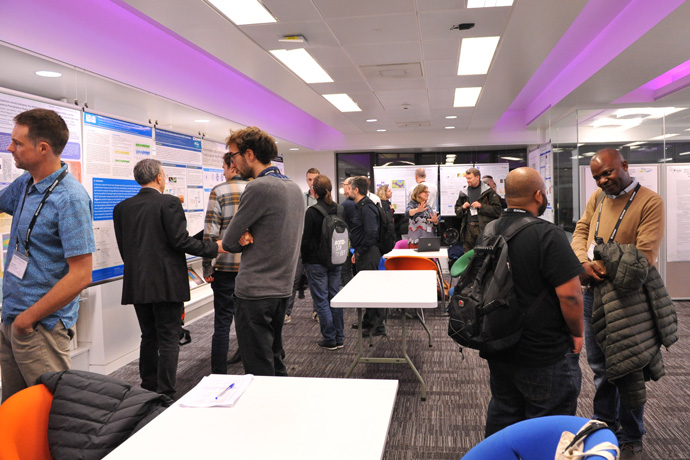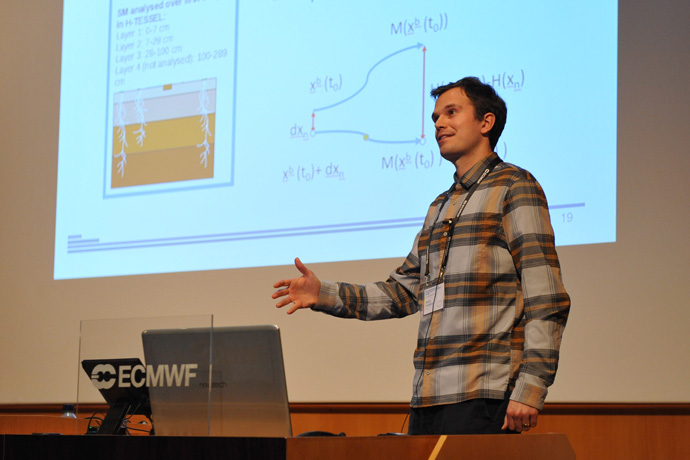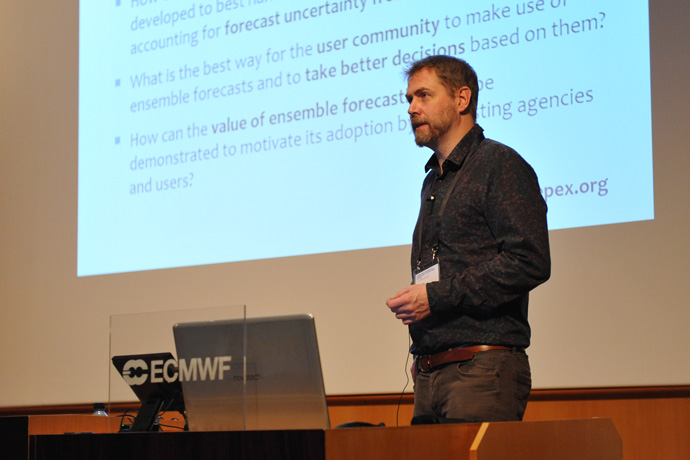

The workshop included poster and demonstration sessions as well as 35 talks.
More than a hundred modellers and satellite data specialists in the field of hydrology came together at ECMWF from 25 to 28 November to debate new ideas and deepen collaborations.
Hydrology is the study of the Earth’s water system. It is essential for understanding weather, floods, droughts and climate change.
The workshop on ‘satellite-inspired hydrology in an uncertain future’ was organised jointly by the EUMETSAT Satellite Application Facility for hydrology and water management (H SAF) and the HEPEX community of specialists in hydrological ensemble prediction.
ECMWF has a stake in both: for H SAF, ECMWF develops, produces and maintains the root zone soil moisture product, while the Centre’s scientists involved in flood risk prediction are active players in HEPEX.
“This event proved a great success for ECMWF and for our partners in H SAF and HEPEX,” says Patricia de Rosnay, one of three co-organisers of the workshop at the Centre. “In the talks, we heard of new methods, for example to estimate land surface conditions at the start of forecasts, and participants made several concrete recommendations useful to ECMWF.”

Patricia de Rosnay leads the coupled data assimilation team at ECMWF.
Combining satellite data
Filipe Aires, a CNRS researcher at the LERMA laboratory in Paris, presented his work on combining hydrological satellite data without using a complex and computationally costly data assimilation system.
“Traditionally hydrological satellite data products concern just one variable, such as precipitation, evaporation or runoff,” he points out.
“However, these may not be entirely consistent. We have managed to obtain a more coherent dataset for all variables by applying certain physical constraints, such as closing the water budget, and exploiting our knowledge of uncertainties in the data.”
His method leads to a temporally and spatially complete hydrological dataset, albeit at a lower resolution than can be achieved when observations and model information are combined in a data assimilation system.

Filipe Aires gave a talk on optimising satellite datasets to study the water cycle at the global scale.
Using lake data to improve flow forecasts
Albrecht Weerts, Professor of Hydrological Predictability at Wageningen University & Research in the Netherlands, gave a talk on improving hydrological predictions through data assimilation.
One of the results he presented is that information on river flow and water levels in lakes can be used to draw conclusions on the upstream flow and states.
“Data assimilation systems can use discharge and lake measurements to back-update the model state at a time before the measurements were made,” he points out.
“The updated model state can then better reflect slow processes in the hydrological cycle. This has a positive impact on forecasts, for example low-flow forecasts for the Rhine basin.”

Albrecht Weerts presented results from the EU-funded IMPREX project and the eWaterCycle II project based at Delft University of Technology.
Conclusions and recommendations
“Filipe’s and Albrecht’s findings are just two examples of a host of inspiring results we heard about at the workshop,” says ECMWF scientist David Fairbairn, who co-organised the event.
“One of the fastest-moving areas is machine learning in satellite data retrieval and data assimilation. We already make use of neural networks in hydrological data assimilation at ECMWF, but there is scope to expand our use of such methods.”

David Fairbairn chaired a session on H SAF products and quality assessment.
Workshop recommendations relevant to numerical weather prediction at ECMWF include considering the assimilation of rain radar data over Europe and promoting in-situ measurement networks in developing countries for validation purposes.
“It was great for so many different perspectives to be brought together in the 35 talks, two poster sessions and four H SAF/HEPEX product demonstration sessions,” says Fredrik Wetterhall, ECMWF’s HEPEX representative on the 12-member organising committee.
“At HEPEX, we are interested in making more use of existing data, for example to improve initial conditions for hydrological modelling,” he adds. “I found the talks on creating long, harmonised times series from multiple sources especially interesting as hydrologists need long time series of data to train their models.”

Fredrik Wetterhall gave a talk on challenges for the HEPEX community in the coming years.
A demonstration session that followed the workshop aimed to familiarise users with various applications of H SAF and HEPEX products. “I found this session very valuable especially since I can continue to access the products outside of the meeting and learn from them in my own time," says Cristina Charlton-Perez, a senior scientist from the UK Met Office.
This was the second H SAF/HEPEX workshop after a first meeting took place in 2014. “There was broad agreement that this type of meeting is extremely useful and that another workshop should be organised in five years’ time,” says Patricia.
Further information
For more information, including the posters, presentations and recordings, visit the workshop page on the ECMWF website.
